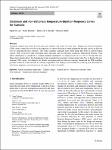Thông tin tài liệu
Thông tin siêu dữ liệu biểu ghi
| Trường DC | Giá trị | Ngôn ngữ |
|---|---|---|
| dc.contributor.author | Laz, Orpita U. | - |
| dc.contributor.author | Rahman, Ataur | - |
| dc.contributor.author | Ouarda, Taha B. M. J. | - |
| dc.date.accessioned | 2023-10-04T08:36:07Z | - |
| dc.date.available | 2023-10-04T08:36:07Z | - |
| dc.date.issued | 2023 | - |
| dc.identifier.uri | https://link.springer.com/article/10.1007/s00477-023-02518-w | - |
| dc.identifier.uri | https://dlib.phenikaa-uni.edu.vn/handle/PNK/9457 | - |
| dc.description | CC-BY | vi |
| dc.description.abstract | Australian summer heat events have become more frequent and severe in recent times. Temperature-duration-frequency (TDF) curves connect the severity of heat episodes of various durations to their frequencies and thus can be an effective tool for analysing the heat extremes. This study examines Australian heat events using data from 82 meteorological stations. TDF curves have been developed under stationary and non-stationary conditions. Generalised Extreme Value (GEV) distribution is considered to estimate extreme temperatures for return periods of 2, 5, 10, 25, 50 and 100 years. Three major climate drivers for Australia have been considered as potential covariates along with Time to develop the non-stationary TDF curves. | vi |
| dc.language.iso | en | vi |
| dc.publisher | Springer | vi |
| dc.subject | TDF | vi |
| dc.subject | GEV | vi |
| dc.title | Stationary and non-stationary temperature-duration-frequency curves for Australia | vi |
| dc.type | Book | vi |
| Bộ sưu tập | ||
| OER - Khoa học môi trường | ||
Danh sách tệp tin đính kèm:

